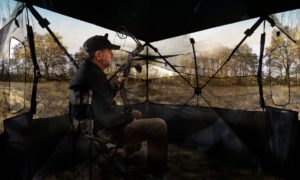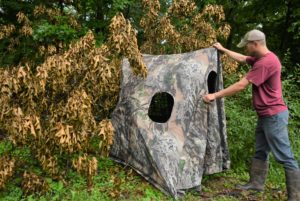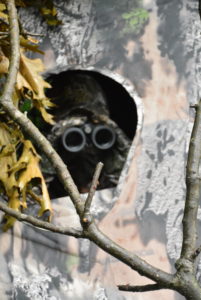Tree stands aren’t the only method of hunting whitetail deer. More and more hunters are coming “down to earth” and scoring on big deer using today’s technologically advanced pop-up blinds. For example, brothers Scott and Steve Esker (pictured above) have taken multiple Boone & Crockett bucks from their Ohio ground blinds over the past decade and now hunt almost exclusively from them.
Ground blinds have improved in ease of setup, camouflage, and silhouette in recent years such that they now compete with tree stands for effectiveness. If you’ve never hunted from “ground zero,” here’s a look at three top models that may change your hunting style forever.
Primos Surroundview 180 and 360

One of the coolest innovations at the 2018 ATA Show was the introduction of the Primos Surroundview ground blind. “A hunter came to us with this idea and we loved it instantly,” Will Primos told me as he proudly showed off the new concept. “You can see out, but deer can’t see in.”
Operating on the concept of tinted car windows or those rear window decals, these unique blinds allow for half (180) or full (360) vision surrounding the blind. A key to effectively hunting from a ground enclosure is to keep the interior as dark as possible. With traditional blinds, if a person opens all of the shooting windows for the best vision, the inside daylight allows game to spot movement. With the Surroundview models, you can keep one or two shooting windows cracked and still see game approach while maintaining darkness inside the blind. www.primos.com
Mantis Breaks the Mold

NAP’s two and three-hub blinds also captured a lot of attention among those perusing new products at the Archery Trade Association Show, thanks to its unique silhouette. One downside of traditional hub blinds is its silhouette, which becomes easily identified due to its round, dome nature. I once turkey-hunted in a new section of turkey woods. Entering in darkness, I settled against a large oak waiting for daylight. Even as the first rays of light filtered through the trees, I noticed a circular object that seemed out of place. Sure enough, my small binoculars showed it to be a ground blind and I quickly backed away.
The Mantis is not only irregularly shaped but ultra easy to set up. I experimented with the one-man two-hub model and it literally goes up in seconds, even in the dark. Most blinds have five hubs that can be complicated to “pop,” yet two hubs give the blind stability and ultra-ease of setup. www.newarchery.com
Rhinoblind’s XP-1 and Cut & Run Blinds
Rhino Blinds feature a unique camouflage pattern and two concepts for hunting. The XP-1 features an “out of the bag and up in 30 seconds,” while the Cut & Run does the same in 20 seconds. Mobility is important in a ground blind strategy and you want to be able to place your blind in the best position possible. Just like tree stand hunting, you can move your ambush point to take advantage of fresh scrapes and rub lines, except you don’t have to have a straight tree to hunt there. Additionally, if the wind is wrong, the blind can be easily moved to the downwind side.

Rhino’s Cut & Run Blind is unique for its extreme mobility. It consists of two sides, which allows a hunter to be concealed from approaching game and can be deployed in and over existing cover. This is perfect for deer hunters who also enjoy spring gobbler action, and the Cut & Run will effectively do double duty.
If you are new to ground blinds, the Rhino Blind instructional video shows how easy popping an enclosed structure can be. You’ll find more details at www.rhinoblinds.com and ain this YouTube video below.



















![The Best Deer Camp Chili [VIDEO] Deer Chili Ingredients, Tomatoes, Chili Spices](/wp-content/uploads/2015/10/Deer-Chili-Deer-Camp-Recipe-218x150.jpg)
![How to Call Elk Early in the Season [VIDEO]](/wp-content/uploads/2016/08/byers003-218x150.jpg)




![Idiots Disturb Hunter: How Would You Have Handled It? [VIDEO]](/wp-content/uploads/2015/10/DSC00110-e1474487693878-100x70.jpg)
![Albino Buck Shocked to Shed His Antlers [VIDEO]](/wp-content/uploads/2015/10/AlbinoDeer-100x70.jpg)